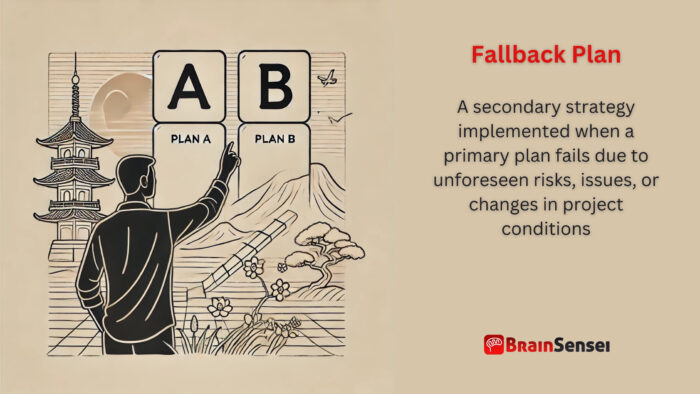
Fallback Plan
What is a Fallback Plan?
A fallback plan is a secondary strategy implemented when a primary plan fails due to unforeseen risks, issues, or changes in project conditions. Unlike a contingency plan, which is activated when predefined risks occur, a fallback plan serves as a last resort when initial risk responses prove ineffective.
Key Takeaways
- A fallback plan is a backup strategy activated when the primary risk response fails.
- It ensures project continuity despite unexpected challenges.
- It differs from a contingency plan, which is triggered by anticipated risks.
- Essential for risk management in complex projects.
- Requires periodic review and updating to stay relevant.
Understanding the Fallback Plan
How It Works
A fallback plan is an essential part of risk management in project planning. Project managers identify critical risks and establish mitigation strategies. However, if these measures fail, they can activate a fallback plan. The plan provides a structured response to minimize project disruptions and ensure alternative paths to project completion.
Notes
- Fallback plans should align with organizational objectives.
- They should be realistic, feasible, and resource-conscious.
- Stakeholders must be aware of fallback options in advance.
- The team should review and test the fallback plan periodically.
- Fallback strategies should include clear decision-making criteria.
Related Terms
- Contingency Plan: A pre-defined course of action to address specific risks if they materialize.
- Risk Mitigation: Strategies to reduce the likelihood or impact of identified risks.
- Business Continuity Plan: A broader strategy ensuring operations continue during disruptions.
- Project Risk Management: Identifying, analyzing, and responding to risks.
- Change Management: Managing modifications in a project’s scope, process, or objectives.
- Disaster Recovery Plan: A structured approach to recover from major disruptive events.
Examples of Fallback Plans in Different Industries
Construction Industry
A large-scale infrastructure project includes backup suppliers if a primary material provider fails to deliver. If delays occur, the project manager activates pre-arranged agreements with alternative vendors to keep the project on schedule. Work schedules and additional labour teams can be a fallback strategy if unexpected weather conditions impact progress.
Another scenario involves labour shortages due to unforeseen strikes or workforce unavailability. In this case, the project manager ensures that agreements with subcontractors are in place to provide additional skilled workers if necessary. With these measures, the construction company met the deadlines and stayed within budget.
IT & Software Development
A software development firm relies heavily on cloud services for data storage and application deployment. If the primary cloud provider experiences an outage, the fallback plan includes an automatic switch to a secondary provider with mirrored data backups. This process ensures that customers experience minimal downtime and that business operations continue smoothly.
Additionally, cybersecurity is a significant concern in IT projects. If a security breach compromises company data, the fallback plan dictates an immediate transition to a secure backup environment, ensuring critical data is not lost. The firm also has predefined incident response protocols, including notifying customers and regulatory bodies in compliance with legal requirements.
Healthcare Industry
A hospital implementing a new patient management system has a fallback plan to revert to manual record-keeping in case the software experiences technical failures. This plan ensures uninterrupted patient care and data integrity. Additionally, a secondary supplier for critical medical supplies is pre-approved to address potential disruptions in supply chains.
Hospitals must also prepare fallback plans for staff shortages during public health crises like pandemics or natural disasters. Cross-training personnel and implementing telehealth solutions allow hospitals to maintain patient care even under extreme circumstances. Hospitals maintain agreements with neighbouring facilities to share resources if critical medical equipment fails temporarily.
Retail and E-commerce
Retail companies rely on an automated warehouse management system to efficiently fulfill orders. If the primary system malfunctions, a fallback plan involves reverting to a manual order processing system to prevent disruptions in customer deliveries.
Retailers have pre-negotiated agreements with alternative suppliers to manage supply chain disruptions and maintain stock levels. If a key supplier cannot deliver products due to geopolitical issues or production failures, the fallback plan ensures a swift transition to an alternative supplier without affecting product availability.
Additionally, e-commerce platforms often experience cyber threats like data breaches or server outages. A fallback strategy involving redundant server backups and cybersecurity protocols helps mitigate risks and protect customer data.
Financial Services Sector
A financial institution preparing for cyber threats maintains a fallback plan that includes alternative trading platforms and emergency security protocols. If primary cybersecurity measures fail, the fallback ensures minimal service disruption and protects customer data.
Another critical area for fallback planning in finance is market instability. Pre-established alternative investment strategies allow firms to minimize risks and ensure business continuity if a sudden economic downturn or currency fluctuation occurs. Additionally, financial institutions must maintain redundant IT infrastructures to prevent downtime in digital banking services.
Aerospace and Defense
An aerospace company manufacturing critical components for aircraft must ensure consistent product delivery despite global supply chain challenges. A fallback plan involves utilizing secondary production facilities in different regions to mitigate disruptions caused by natural disasters or geopolitical tensions.
Additionally, for defence projects, fallback strategies ensure alternative procurement channels for essential components to prevent delays in mission-critical developments. If communication systems fail, backup satellite communication links are activated to maintain real-time operations.
By integrating comprehensive fallback strategies, these industries safeguard their operations against unexpected failures, ensuring long-term business continuity and customer satisfaction.
Use Cases of Fallback Plans
United States (Financial Services Sector)
A financial institution in the United States implements a fallback plan to ensure business continuity during a cybersecurity attack. The company maintains a secondary data center in a different region, allowing a seamless transition of operations if the primary center is compromised. In addition, alternative trading platforms are available if primary systems experience downtime. This strategy protects customer data and prevents significant financial losses. The institution also conducts routine cybersecurity drills to test and refine fallback strategies.
In another scenario, a large credit card company faces a regulatory change that impacts transaction processing. Their fallback plan includes pre-approved partnerships with third-party processing firms that can handle excess transactions while internal systems are updated to meet new compliance requirements. This plan prevents service disruptions and maintains customer trust.
Germany (Manufacturing Industry)
A German automobile manufacturer faces an unexpected supply chain disruption due to a geopolitical crisis. The company’s fallback plan includes agreements with secondary parts suppliers in different regions. Within days of the primary supplier shutting down, the manufacturer activates its alternative supply chain, ensuring production remains on schedule.
Additionally, the manufacturer has an established protocol for workforce shortages. If labour strikes or pandemics impact worker availability, the company implements automated production lines and temporary workforce contracts to keep production moving. These measures reduce financial losses and meet market demand despite external disruptions.
Another example is a pharmaceutical company in France that experiences raw material shortages. Their fallback plan involves collaborating with international suppliers who can quickly ship alternative materials that meet regulatory standards. By having pre-negotiated contracts, the company ensures that production timelines remain intact.
Japan (Telecommunication Sector)
A leading telecom provider in Japan prepares for natural disasters by maintaining a fallback plan that includes emergency satellite connectivity. The company immediately shifts critical communications to satellite-based networks if an earthquake or typhoon disrupts fibre-optic infrastructure. This plan ensures continued service for emergency responders, businesses, and individuals relying on stable internet and communication services.
Additionally, the telecom provider has backup power solutions, such as fuel cell generators and battery storage, to maintain tower functionality during prolonged power outages. Network redundancy measures prevent widespread service disruptions, including mobile base stations and distributed data centers.
A similar strategy is employed by an Indian telecom company facing unexpected government regulations limiting data usage. The firm implements a fallback strategy that redirects traffic through alternative routing systems, minimizing customer impact. Additionally, it engages legal teams to challenge and negotiate with regulators while keeping customers informed about expected service updates.
Brazil (Energy Sector)
An oil and gas company in Brazil faces political instability and policy changes that affect its drilling operations. To counteract these risks, the company establishes operations in multiple regions and maintains flexible drilling schedules that the team can adjust based on regulatory changes. If one area becomes nonviable, drilling shifts to another, ensuring that output levels remain consistent.
Additionally, the firm maintains agreements with logistics companies to secure transportation routes for crude oil, even if political unrest disrupts primary routes. Having multiple transport contracts prevents bottlenecks and delays in product delivery.
United Arab Emirates (Aviation Industry)
A major airline in the United Arab Emirates prepares for geopolitical disruptions by maintaining agreements with alternative fuel suppliers. If regional tensions affect fuel supply chains, the airline swiftly switches to pre-negotiated secondary suppliers to avoid flight cancellations.
Furthermore, the airline has a fallback plan for airspace restrictions. In case of sudden airspace closures due to political conflicts, the company has pre-approved alternative flight paths and agreements with international aviation authorities to maintain passenger schedules.
An airport management company experiencing IT system failures provides a similar example. Their fallback plan includes manual check-in and boarding processes, ensuring airport operations continue smoothly despite system outages.
By integrating comprehensive fallback strategies, these industries ensure resilience against unexpected failures, safeguarding long-term business continuity and stakeholder confidence.
Best Practices for Developing a Fallback Plan
Developing a fallback plan requires careful planning, structured implementation, and continuous evaluation. Here are key best practices:
Identify Critical Risks
Organizations must first identify potential risks that could disrupt operations to create a robust fallback plan. Identifying risks includes assessing internal and external risks, such as financial instability, cyber threats, supply chain disruptions, and natural disasters.
A comprehensive risk assessment should involve:
- Conducting SWOT (Strengths, Weaknesses, Opportunities, Threats) analysis.
- Consulting stakeholders to identify potential failure points.
- Using historical data and industry trends to predict risks.
Define Clear Triggers
A well-structured fallback plan defines triggers that determine when to activate the plan. These triggers should be measurable, objective, and communicated.
Examples of triggers include:
- A critical system failure exceeding 30 minutes of downtime.
- Supply chain disruptions that delay production by more than 72 hours.
- Regulatory changes that impact more than 10% of business operations.
Establish Alternative Strategies
Fallback plans should outline multiple alternative strategies for effectively responding to risks. The plan should include identifying secondary vendors, backup communication channels, and redundant operational procedures.
Some fallback strategies include:
- Establishing partnerships with alternative suppliers to prevent supply chain bottlenecks.
- Implementing cloud-based solutions for remote access during IT system failures.
- Cross-training employees to ensure business continuity during workforce shortages.
Assign Roles and Responsibilities
Every fallback plan should clearly define each team member’s roles and responsibilities. Assigning ownership ensures that individuals know their responsibilities during crises.
Best practices for role assignment include:
- Designating an incident response team with clear reporting structures.
- Establishing emergency communication protocols.
- Training employees on their specific fallback duties through regular simulations.
Allocate Resources in Advance
A fallback plan is only effective if resources are readily available when needed. Organizations should allocate budget, personnel, and technological tools to support fallback strategies.
Key resource allocation measures include:
- Maintaining financial reserves for emergency procurement.
- Investing in redundant IT infrastructure and data backups.
- Stockpiling essential materials for industries with critical supply chain dependencies.
Conduct Regular Testing and Simulations
Regular testing is essential to ensure the effectiveness of a fallback plan. Organizations should conduct scenario-based simulations and tabletop exercises to evaluate response times and identify potential weaknesses.
Recommended testing approaches:
- Quarterly or biannual fallback plan drills.
- Simulated system failures to assess IT resilience.
- Crisis management workshops involving key stakeholders.
Maintain Compliance with Regulations
Regulatory requirements vary across industries, requiring organizations to align fallback plans with legal standards. In financial services, healthcare, and aviation, non-compliance with legal standards can result in penalties.
Steps to ensure compliance:
- Regularly reviewing updates in industry regulations.
- Collaborating with legal advisors to align fallback measures with regulatory requirements.
- Documenting fallback strategies to meet audit and compliance standards.
Communicate the Plan to Stakeholders
A fallback plan is ineffective if key stakeholders are unaware of its existence or unsure about their roles in execution. Effective communication ensures smooth implementation in times of crisis.
Communication strategies:
- Hosting training sessions for employees and managers.
- Providing written documentation outlining the fallback procedures.
- Establishing a dedicated emergency response contact point.
Continuously Review and Improve the Plan
Risk landscapes evolve, and the team must update the fallback plans to reflect changing conditions. Organizations should conduct periodic reviews and incorporate lessons learned from previous activations.
Key improvement methods:
- Gathering feedback from stakeholders after a fallback plan execution.
- Updating risk assessments to include emerging threats.
- Using data analytics to refine decision-making processes.
Integrate FallBack Plan with Business Continuity Plans
A fallback plan should not operate in isolation. Integrating it seamlessly with broader business continuity and disaster recovery plans ensures alignment with company objectives and risk management frameworks.
Best integration practices:
- Mapping fallback measures to existing business continuity frameworks.
- Ensuring IT disaster recovery plans align with operational fallback strategies.
- Incorporating fallback considerations in enterprise-wide risk assessments.
Conclusion: A well-developed fallback plan is a critical component of risk management. Organizations can ensure business continuity despite unforeseen disruptions by identifying risks, defining clear triggers, allocating resources, and regularly testing strategies. Consistently refining and integrating fallback plans within broader business continuity strategies helps organizations remain resilient and adaptable in an ever-changing risk landscape.
Fallback Plan: Common Mistakes and Issues
A fallback plan is crucial for risk management, but several common mistakes can undermine its effectiveness. Understanding these pitfalls can help organizations avoid costly disruptions.
Failing to Test Alternative Solutions
One of the most significant mistakes is assuming the fallback plan will work without testing. Many organizations outline alternative solutions but fail to validate them in real-world scenarios. When a crisis occurs, they discover gaps, delays, or impracticalities that render the fallback plan ineffective.
To prevent this, organizations should conduct regular simulations, stress tests, and scenario analyses to evaluate the plan’s feasibility. Periodic drills help uncover weaknesses and provide insights into necessary adjustments.
Poor Stakeholder Communication
A fallback plan is only effective if all relevant stakeholders know its details and understand their roles in executing it. When the plan is activated, inadequate communication leads to confusion and inefficiencies. Employees, suppliers, and clients may not know the necessary steps to take, exacerbating disruptions.
Organizations should implement clear communication protocols to mitigate this, provide comprehensive training, and ensure all relevant parties receive updated documentation. Establishing a chain of command and designated points of contact enhances response efficiency.
Neglecting Resource Allocation
Many organizations develop fallback plans without securing the resources needed to implement them. These resources include financial reserves, human resources, alternative suppliers, or redundant IT systems. When the fallback plan is required, the lack of pre-allocated resources can render it ineffective.
It is crucial to ensure that backup resources are available and ready for deployment. Key steps include negotiating pre-approved agreements with vendors, maintaining an emergency budget, and pre-positioning essential materials or personnel.
Overlooking Regulatory and Compliance Issues
Regulatory requirements differ across industries, and failing to align fallback plans with these regulations can result in legal penalties or operational delays. Many organizations overlook compliance requirements when designing fallback strategies, leading to unexpected legal and financial complications.
Organizations should work closely with legal advisors to ensure their fallback plans comply with industry regulations. The risk management framework should incorporate regular compliance reviews to account for evolving legal landscapes.
Relying on a Single Fallback Plan
A common mistake is developing only one fallback plan without considering multiple contingencies. Organizations may lack viable alternatives if the primary fallback plan fails, leading to prolonged disruptions.
To prevent this common mistake, businesses should create layered fallback strategies with multiple response options. These plans involve securing multiple suppliers, redundant IT systems, and diverse operational workflows to adapt to crises.
Lack of Periodic Review and Updates of a Fallback Plan
Risk environments change over time, and fallback plans that are not regularly updated can become obsolete. An organization that fails to review and adjust its fallback strategies risks being unprepared for emerging threats.
To stay proactive, organizations should schedule periodic reviews of their fallback plans. They should incorporate lessons from past activations and adjust strategies based on evolving risks. Stakeholder feedback and industry trends should inform these updates.
Ignoring Cultural and Regional Considerations
Global organizations often implement uniform fallback plans without accounting for regional differences in regulations, infrastructure, and workforce capabilities. Activating a fallback plan in different locations can lead to inefficiencies.
Organizations should customize fallback plans to accommodate regional differences, ensuring local teams are involved in planning. Cultural awareness and localized resource allocation enhance the plan’s applicability in diverse environments.
Misjudging Risk Severity
Some organizations misjudge the likelihood or impact of certain risks, leading to inadequate fallback plans. They may focus on minor risks while overlooking critical threats that could disrupt operations.
A thorough risk assessment should prioritize high-impact risks and develop proportionate fallback measures. Scenario modelling and historical data analysis help organizations allocate resources effectively and prepare for the most probable disruptions.
Failure to Align Fallback Plan with Business Continuity Strategies
A fallback plan should not function in isolation—it must align with broader business continuity and disaster recovery plans. Creating fallback plans independently from them can lead to inconsistencies, reducing their effectiveness in a crisis.
To address this, organizations should integrate fallback planning within their overall risk management strategy, ensuring all emergency responses work cohesively to maintain operational stability.
Conclusion: Avoiding these common mistakes is essential to developing an effective fallback plan. Organizations can enhance resilience and minimize disruptions by proactively testing solutions, ensuring resource availability, communicating with stakeholders, and updating plans regularly. Fallback planning should be an ongoing process that evolves alongside business needs and external risk factors to provide reliable contingency measures in an ever-changing environment.
Fallback Plan: Frequently Asked Questions (FAQs)
What is the difference between a fallback plan and a contingency plan?
A contingency plan is a proactive strategy prepared for anticipated risks, while a fallback plan is a last resort used when primary risk responses fail.
How do you create an effective fallback plan?
Identify potential failure points in your risk response plan, outline clear alternative actions, allocate necessary resources, and test the plan to ensure its effectiveness.
Why is a fallback plan important in project management?
It ensures project continuity by providing a secondary approach when initial risk mitigation strategies do not work.
How often should a fallback plan be updated?
Regularly, at least once per project phase, or when significant project changes or new risks emerge.
Can a fallback plan be the same as a disaster recovery plan?
No. A disaster recovery plan is a comprehensive strategy for recovering from catastrophic failures, whereas a fallback plan is a short-term response to specific project risks.
Additional Resources
Preparing for a PMI certification?
- Exam Prep Courses: PMP®, CAPM®, and PMI-ACP®
- Exam Simulators: PMP®, CAPM®, PMI-ACP®, PMI-PBA®, PMI-RMP®, PMI-SP®, PgMP®, and PfMP®
- Professional Development Units (PDUs): 15, 30, and 60 PDU Bundles



